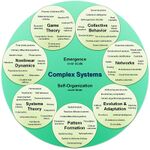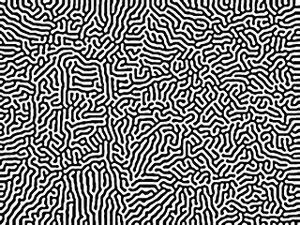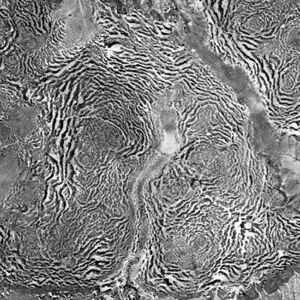斑图
此词条暂由彩云小译翻译,翻译字数共484,未经人工整理和审校,带来阅读不便,请见谅。
 |
| Complex systems |
|---|
| Topics |
Pattern formation in a computational model of dendrite growth.
在枝晶生长的计算模型中形成图案
The science of pattern formation deals with the visible, (statistically) orderly outcomes of self-organization and the common principles behind similar patterns in nature.
The science of pattern formation deals with the visible, (statistically) orderly outcomes of self-organization and the common principles behind similar patterns in nature.
模式形成的科学研究的是可见的、(统计学上)有序的自我组织和自然界中相似模式背后的共同原理。
In developmental biology, pattern formation refers to the generation of complex organizations of cell fates in space and time. Pattern formation is controlled by genes. The role of genes in pattern formation is an aspect of morphogenesis, the creation of diverse anatomies from similar genes, now being explored in the science of evolutionary developmental biology or evo-devo. The mechanisms involved are well seen in the anterior-posterior patterning of embryos from the model organism Drosophila melanogaster (a fruit fly), one of the first organisms to have its morphogenesis studied and in the eyespots of butterflies, whose development is a variant of the standard (fruit fly) mechanism.
In developmental biology, pattern formation refers to the generation of complex organizations of cell fates in space and time. Pattern formation is controlled by genes. The role of genes in pattern formation is an aspect of morphogenesis, the creation of diverse anatomies from similar genes, now being explored in the science of evolutionary developmental biology or evo-devo. The mechanisms involved are well seen in the anterior-posterior patterning of embryos from the model organism Drosophila melanogaster (a fruit fly), one of the first organisms to have its morphogenesis studied and in the eyespots of butterflies, whose development is a variant of the standard (fruit fly) mechanism.
在发育生物学,模式形成指的是细胞在空间和时间中命运的复杂组织的产生。模式的形成是由基因控制的。基因在模式形成中的作用是形态发生的一个方面,即从相似的基因中创造出不同的解剖结构,目前正在演化发育生物学科学或演化发育生物学中探索。模式生物黑腹果蝇(一种果蝇)的胚胎的前后部图案和蝴蝶的眼点都清楚地表明了其中的机制,前者是最早研究其形态发生的生物之一,后者的发育是标准(果蝇)机制的变体。
Examples
Examples of pattern formation can be found in biology, chemistry, physics, and mathematics,[1] and can readily be simulated with computer graphics, as described in turn below.
Examples of pattern formation can be found in biology, chemistry, physics, and mathematics, In contrast, fir waves occur in forests on mountain slopes after wind disturbance, during regeneration. When trees fall, the trees that they had sheltered become exposed and are in turn more likely to be damaged, so gaps tend to expand downwind. Meanwhile, on the windward side, young trees grow, protected by the wind shadow of the remaining tall trees. In flat terrains additional pattern morphologies appear besides stripes - hexagonal gap patterns and hexagonal spot patterns. Pattern formation in this case is driven by positive feedback loops between local vegetation growth and water transport towards the growth location. The emergence of pattern formation can be studied by mathematical modeling and simulation of the underlying reaction-diffusion system.
在生物学、化学、物理学和数学中都可以找到模式形成的例子。相反,在风扰动之后,在更新期间,冷杉波发生在山坡上的森林中。当树木倒下的时候,它们曾经庇护过的树木变得暴露,反过来更有可能受到损害,所以缝隙往往在下风处扩大。与此同时,在迎风面,年轻的树木生长,受到剩余高大树木的风影的保护。在平面地形中,除了条纹、六角形缝隙图案和六角形斑点图案外,还出现了其他图案形态。在这种情况下,格局的形成是由当地植被生长和水向生长地点输送之间的正反馈循环驱动的。模式形成的出现可以用潜在的反应扩散系统的数学建模与模拟来研究。
Biology
Biological patterns such as animal markings, the segmentation of animals, and phyllotaxis are formed in different ways.[2]
In developmental biology, pattern formation describes the mechanism by which initially equivalent cells in a developing tissue in an embryo assume complex forms and functions.[3] Embryogenesis, such as of the fruit fly Drosophila, involves coordinated control of cell fates.[4][5][6] Pattern formation is genetically controlled, and often involves each cell in a field sensing and responding to its position along a morphogen gradient, followed by short distance cell-to-cell communication through cell signaling pathways to refine the initial pattern. In this context, a field of cells is the group of cells whose fates are affected by responding to the same set positional information cues. This conceptual model was first described as the French flag model in the 1960s.[7][8] More generally, the morphology of organisms is patterned by the mechanisms of evolutionary developmental biology, such as changing the timing and positioning of specific developmental events in the embryo.[9]
In the 1980s Lugiato and Lefever developed a model of light propagation in an optical cavity that results in pattern formation by the exploitation of nonlinear effects.
在20世纪80年代,Lugiato 和 Lefever 发展了一个光在光学腔中传播的模型,这个模型通过利用非线性效应来形成图案。
Possible mechanisms of pattern formation in biological systems include the classical reaction–diffusion model proposed by Alan Turing[10] and the more recently found elastic instability mechanism which is thought to be responsible for the fold patterns on the cerebral cortex of higher animals, among other things.[11][12]
Bénard cells, laser, cloud formations in stripes or rolls. Ripples in icicles. Washboard patterns on dirtroads. Dendrites in solidification, liquid crystals. Solitons.
贝纳德细胞,激光,条纹或滚动的云层。冰柱上的涟漪。十字架上的搓板图案。凝固过程中的树枝晶、液晶。孤子。
Growth of colonies
Bacterial colonies show a large variety of patterns formed during colony growth. The resulting shapes depend on the growth conditions. In particular, stresses (hardness of the culture medium, lack of nutrients, etc.) enhance the complexity of the resulting patterns.[13] Other organisms such as slime moulds display remarkable patterns caused by the dynamics of chemical signaling.[14]
Vegetation patterns
Sphere packings and coverings. Mathematics underlies the other pattern formation mechanisms listed.
球形填料和覆盖物。数学是其他模式形成机制的基础。
Vegetation patterns such as tiger bush[15] and fir waves[16] form for different reasons. Tiger bush consists of stripes of bushes on arid slopes in countries such as Niger where plant growth is limited by rainfall. Each roughly horizontal stripe of vegetation absorbs rainwater from the bare zone immediately above it.[15] In contrast, fir waves occur in forests on mountain slopes after wind disturbance, during regeneration. When trees fall, the trees that they had sheltered become exposed and are in turn more likely to be damaged, so gaps tend to expand downwind. Meanwhile, on the windward side, young trees grow, protected by the wind shadow of the remaining tall trees.[16] In flat terrains additional pattern morphologies appear besides stripes - hexagonal gap patterns and hexagonal spot patterns. Pattern formation in this case is driven by positive feedback loops between local vegetation growth and water transport towards the growth location.[17][18]
Pattern resembling a reaction–diffusion model, produced using sharpen and blur
图案类似于反应扩散模型,使用锐化和模糊
Chemistry
模板:FurtherPattern formation has been well studied in chemistry and chemical engineering, including both temperature and concentration patterns.[19] The Brusselator model developed by Ilya Prigogine and collaborators is one such example that exhibits Turing instability.[20] Pattern formation in chemical systems often involve oscillatory chemical kinetics or autocatalytic reactions[21] such as Belousov–Zhabotinsky reaction or Briggs–Rauscher reaction. In industrial applications such as chemical reactors, pattern formation can lead to temperature hot spots which can reduce the yield or create hazardous safety problems such as a thermal runaway.[22][19] The emergence of pattern formation can be studied by mathematical modeling and simulation of the underlying reaction-diffusion system.[19][21]
Some types of automata have been used to generate organic-looking textures for more realistic shading of 3d objects.
一些类型的自动机已经被用来生成看起来有机的纹理,以获得更加真实的三维物体着色。
A popular Photoshop plugin, KPT 6, included a filter called 'KPT reaction'. Reaction produced reaction–diffusion style patterns based on the supplied seed image.
一个流行的 Photoshop 插件 KPT 6,包含了一个叫做 KPT reaction 的过滤器。基于提供的种子图像,反应产生反应扩散样式的图案。
Physics
A similar effect to the 'KPT reaction' can be achieved with convolution functions in digital image processing, with a little patience, by repeatedly sharpening and blurring an image in a graphics editor. If other filters are used, such as emboss or edge detection, different types of effects can be achieved.
在数字图像处理中,只需一点点耐心,通过在图形编辑器中反复锐化和模糊图像,就可以达到类似于“ KPT 反应”的效果。如果使用其他过滤器,如浮雕或边缘检测,可以实现不同类型的效果。
Computers are often used to simulate the biological, physical or chemical processes that lead to pattern formation, and they can display the results in a realistic way. Calculations using models like reaction–diffusion or MClone are based on the actual mathematical equations designed by the scientists to model the studied phenomena.
计算机经常被用来模拟导致图案形成的生物、物理或化学过程,它们可以以一种逼真的方式显示结果。使用反应扩散或 MClone 等模型的计算是基于科学家为模拟所研究的现象而设计的实际数学方程。
In the 1980s Lugiato and Lefever developed a model of light propagation in an optical cavity that results in pattern formation by the exploitation of nonlinear effects.
Bénard cells, laser, cloud formations in stripes or rolls. Ripples in icicles. Washboard patterns on dirtroads. Dendrites in solidification, liquid crystals. Solitons.
Mathematics
Sphere packings and coverings. Mathematics underlies the other pattern formation mechanisms listed.
Computer graphics

Some types of automata have been used to generate organic-looking textures for more realistic shading of 3d objects.[23][24]
Category:Developmental biology
类别: 发育生物学
A popular Photoshop plugin, KPT 6, included a filter called 'KPT reaction'. Reaction produced reaction–diffusion style patterns based on the supplied seed image.
Category:Articles containing video clips
类别: 包含视频剪辑的文章
This page was moved from wikipedia:en:Pattern formation. Its edit history can be viewed at 斑图/edithistory
- ↑ Ball, 2009.
- ↑ Ball, 2009. Shapes, pp. 231–252.
- ↑ Ball, 2009. Shapes, pp. 261–290.
- ↑ Eric C. Lai (March 2004). "Notch signaling: control of cell communication and cell fate". Development. 131 (5): 965–73. doi:10.1242/dev.01074. PMID 14973298.
- ↑ Melinda J. Tyler, David A. Cameron (2007). "Cellular pattern formation during retinal regeneration: A role for homotypic control of cell fate acquisition". Vision Research. 47 (4): 501–511. doi:10.1016/j.visres.2006.08.025. PMID 17034830.
{{cite journal}}: CS1 maint: uses authors parameter (link) - ↑ Hans Meinhard (2001-10-26). "Biological pattern formation: How cell[s] talk with each other to achieve reproducible pattern formation". Max-Planck-Institut für Entwicklungsbiologie, Tübingen, Germany.
- ↑ Wolpert L (October 1969). "Positional information and the spatial pattern of cellular differentiation". J. Theor. Biol. 25 (1): 1–47. doi:10.1016/S0022-5193(69)80016-0. PMID 4390734.
- ↑ Wolpert, Lewis (2007). Principles of development (3rd ed.). Oxford [Oxfordshire]: Oxford University Press. ISBN 978-0-19-927536-6.
- ↑ Hall, B. K. (2003). "Evo-Devo: evolutionary developmental mechanisms". International Journal of Developmental Biology. 47 (7–8): 491–495. PMID 14756324.
- ↑ S. Kondo, T. Miura, "Reaction-Diffusion Model as a Framework for Understanding Biological Pattern Formation", Science 24 Sep 2010: Vol. 329, Issue 5999, pp. 1616-1620 DOI: 10.1126/science.1179047
- ↑ Mercker, M; Brinkmann, F; Marciniak-Czochra, A; Richter, T (4 May 2016). "Beyond Turing: mechanochemical pattern formation in biological tissues". Biology Direct. 11: 22. doi:10.1186/s13062-016-0124-7. PMC 4857296. PMID 27145826.
- ↑ Tallinen et al. Nature Physics 12, 588–593 (2016) doi:10.1038/nphys3632
- ↑ Ball, 2009. Branches, pp. 52–59.
- ↑ Ball, 2009. Shapes, pp. 149–151.
- ↑ 15.0 15.1 Tongway, D.J., Valentin, C. & Seghieri, J. (2001). Banded vegetation patterning in arid and semiarid environments. New York: Springer-Verlag. ISBN 978-1461265597.
- ↑ 16.0 16.1 D'Avanzo, C. (22 February 2004). "Fir Waves: Regeneration in New England Conifer Forests". TIEE. Retrieved 26 May 2012.
- ↑ Meron, E (2019). "Vegetation pattern formation: the mechanisms behind the forms". Physics Today. 72 (11): 30–36. doi:10.1063/PT.3.4340.
- ↑ Meron, E (2018). "From Patterns to Function in Living Systems: Dryland Ecosystems as a Case Study". Annual Review of Condensed Matter Physics. 9: 79–103. doi:10.1146/annurev-conmatphys-033117-053959.
- ↑ 19.0 19.1 19.2 Gupta, Ankur; Chakraborty, Saikat (January 2009). "Linear stability analysis of high- and low-dimensional models for describing mixing-limited pattern formation in homogeneous autocatalytic reactors". Chemical Engineering Journal. 145 (3): 399–411. doi:10.1016/j.cej.2008.08.025. ISSN 1385-8947.
- ↑ Prigogine, I.; Nicolis, G. (1985), Hazewinkel, M.; Jurkovich, R.; Paelinck, J. H. P. (eds.), "Self-Organisation in Nonequilibrium Systems: Towards A Dynamics of Complexity", Bifurcation Analysis: Principles, Applications and Synthesis, Springer Netherlands, pp. 3–12, doi:10.1007/978-94-009-6239-2_1, ISBN 9789400962392
- ↑ 21.0 21.1 Gupta, Ankur; Chakraborty, Saikat (2008-01-19). "Dynamic Simulation of Mixing-Limited Pattern Formation in Homogeneous Autocatalytic Reactions". Chemical Product and Process Modeling. 3 (2). doi:10.2202/1934-2659.1135. ISSN 1934-2659.
- ↑ Marwaha, Bharat; Sundarram, Sandhya; Luss, Dan (September 2004). "Dynamics of Transversal Hot Zones in Shallow Packed-Bed Reactors†". The Journal of Physical Chemistry B. 108 (38): 14470–14476. doi:10.1021/jp049803p. ISSN 1520-6106.
- ↑ Greg Turk, Reaction–Diffusion
- ↑ Andrew Witkin; Michael Kassy (1991). "Reaction–Diffusion Textures" (PDF). Proceedings of the 18th Annual Conference on Computer Graphics and Interactive Techniques: 299–308. doi:10.1145/122718.122750. ISBN 0897914368.
